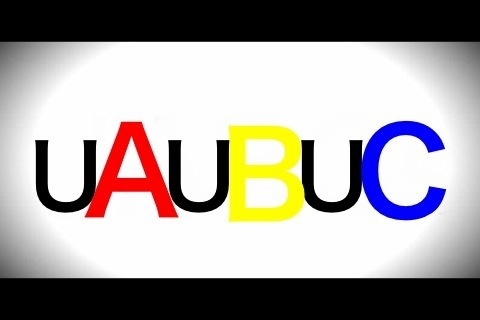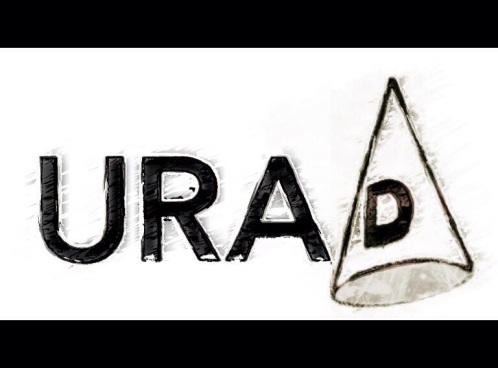This is a modified version of a post I posted on my blog about two years ago, before I joined Twitter. It’s something I thought some of my Twitter followers–especially those concerned about post-secondary education–might find interesting. Also, it provides some clues about the graphics featuring strings of letters that I include with many of my Tweets. Also, I have another reason for ‘reposting’ this now, that I’ll get to at the end of the piece. (The original version of this post was in response to a special Globe and Mail series about post-secondary education that ran in the fall, almost two years ago. I’ve taken out references to that series for this modified version–although the graphics are unchanged. If you’re interested in reading the original version, it can be found here.)
. . . . . . . . . . . . .
The uppermost of the two above pictures is a god-awful mess, wouldn’t you agree? That’s what happens when you’re tired after a long day at work, trying to produce a graphic for a blog post you want to get up as soon as possible, using graphics tools whose versatility can sometimes be more of a hindrance than a help. I was ready to delete the picture from my iPad; but, when I looked at it beside the original version, essentially the picture below it (the original didn’t have the oval frame around the lettering), and realized that the two pictures together fit in with what I planned to write about in my post, it seemed worth preserving.
A big problem with so much recent commentary about universities is that the issue of underlying philosophical change in recent decades within Western society–including within our universities and towards universities, from an outside perspective–has been overlooked. In this period of philosophical transition, there are multiple basic philosophical perspectives towards universities, which differentially affect attitudes towards particular issues. These include attitudes about what should be taught, to whom, by whom, the methods used to teach, and even how university education should be financed. Beneath the surface, to those who have given some thought to the issue of philosophical change as it relates to our universities, some coherence may be discerned among the diverse views about our universities. But, on the surface, this commentary, taken as a whole, is likely to appear to many, if not most, to be an incoherent jumble–and not very useful in helping to further constructive change in our universities.
There are now basically three different philosophical perspectives from which our universities, and aspects thereof, may be viewed. These three perspectives I’ll call here A, B, and C. A book chapter could be written about each of these perspectives; but, since this is just a blog post, I’ll stick to the basics.
The A perspective is the traditional elitist view that predominated in Western universities until the mid-20th Century. Until that time, only a small proportion of the population attended universities, and attendees were almost invariably white males, and from relatively prosperous families. In the second half of the 20th Century, significantly greater diversity among students, and also ultimately among the professoriate, led to a second basic perspective: perspective B. This perspective may be summed up as being that of the “academic left”. Although those from the B camp favour a more inclusive approach to university education than those of the A camp, it should be emphasized that members of the B camp do not question the basic activities conducted within universities. Members of both groups are likely to support traditional university policies and procedures, such as academic freedom (including freedom from interference from those outside universities), academic tenure (or guaranteed jobs for life) for senior professors, the notion of the all-knowing professor as the source of legitimate knowledge for students, and the emphasis on research in the evaluation of professors with little weight given to teaching ability.
By the late 1970s, the basic dualistic and hierarchical framework of Western metaphysics, that had supported Western universities for so long, was crumbling. Both perspectives A and B were now being challenged–mostly from outside of universities. Yet it is worth noting here that, by now, there were many more adults studying in universities than there had been in the past, some of whom, especially those studying at the graduate level, already had achieved mid-career status in their professions, who personally brought the ‘outside’ perspective into our universities. (I was one such student when I was doing graduate work in education.) This third basic perspective, or perspective C, is the ‘postmodern’ perspective–with ‘postmodern’ defined essentially as it is defined by Lyotard in The Postmodern Condition. (You can look it up, if you’re interested.)
If, as I believe is the case, the majority of Canadians now possess the basic C perspective (this distinguishes Canada from the United States) a reasonable reevaluation of our universities has to start explicitly from that position. This doesn’t rule out the possibility of certain institutions and programs catering to those who possess minority A and B perspectives (a Christian-based university, like Trinity Western University, generally falls into the A category); but it does suggest that at least the greater part of funding for such institutions and programs will have to come from somewhere other than general tax revenue.
It would seem to be enormously helpful if commentators on our universities would preface their commentary with some reference to philosophical change in our universities. Better yet, it would be fantastic if influential commentators (like the Globe and Mail newspaper) publicly endorsed a postmodern position. That could be the stimulus Canadians need to really get down to the serious business of reevaluating our universities, and reconstructing them within a non-dualistic, non-hierarchical, framework. But I’m not optimistic. Generally speaking, our influential commentators seems too beholding to those who support the A perspective–or who at least who pretend to support that perspective–for any such thing to happen.
Which brings me to my final point here. I’d love to be able to devote more time to this kind of work. But, for that, I need MONEY. Is there perhaps someone out there reading this who has more money than they need who might be able to help me with this? Or perhaps who knows someone else with money who might be sympathetic to my views? It probably can’t hurt to ask–although I could loose some of my Twitter followers by being so blunt . . . Oh, hell, I’ll post this anyway.





